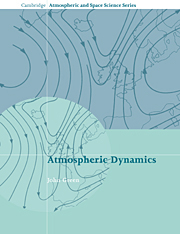Book contents
- Frontmatter
- Contents
- Introduction
- Chapter 1 Description of atmospheric motion systems
- Chapter 2 Notation
- Chapter 3 Fundamental equations
- Chapter 4 Nearly horizontal atmosphere
- Chapter 5 Gravity waves
- Chapter 6 Shearing instability
- Chapter 7 Vertical convection
- Chapter 8 Mesoscale motion
- Chapter 9 Motion of large scale
- Chapter 10 The forecast problem
- Chapter 11 Motion in a barotropic atmosphere
- Chapter 12 Modelling
- Chapter 13 Models
- Chapter 14 Transport and mixing
- Chapter 15 General circulation
- Appendix
- Index
Chapter 10 - The forecast problem
Published online by Cambridge University Press: 17 September 2009
- Frontmatter
- Contents
- Introduction
- Chapter 1 Description of atmospheric motion systems
- Chapter 2 Notation
- Chapter 3 Fundamental equations
- Chapter 4 Nearly horizontal atmosphere
- Chapter 5 Gravity waves
- Chapter 6 Shearing instability
- Chapter 7 Vertical convection
- Chapter 8 Mesoscale motion
- Chapter 9 Motion of large scale
- Chapter 10 The forecast problem
- Chapter 11 Motion in a barotropic atmosphere
- Chapter 12 Modelling
- Chapter 13 Models
- Chapter 14 Transport and mixing
- Chapter 15 General circulation
- Appendix
- Index
Summary
And ever changing,
like a joyless eye
That finds no object worth its constancy?
Perturbations of inconstant shape: the missing baroclinic wave
A major forecast problem is concerned with forecasting development; intensification of more-or-less observable existing systems. While exponentially amplifying waves are a useful description of some aspects of wave generation, they are not the whole story, and there are some paradoxical cases. For example, consider the Eady system, in which the baroclinity is independent of height, with no variation of inertial density, and constant stratification, but with β not necessarily zero, as illustrated in Figure 10.1. With β zero there is a short-wave cut-off to instability at k = 2.4 nearly, and one pair of non-amplifying waves with steering levels above and below the middle level for shorter waves. But with β = +0.01 there is no short-wave cut-off, but only a pair of short waves with steering level near the lower boundary, one amplifying weakly, the other diminishing weakly. The wave that had its steering level near the upper boundary has vanished. Conversely, if β were small and negative, then the lower-level wave would disappear. We argue that these disappearing waves are part of a continuous spectrum of solutions that occasionally attain the property of being of constant shape.
- Type
- Chapter
- Information
- Atmospheric Dynamics , pp. 134 - 143Publisher: Cambridge University PressPrint publication year: 1999

